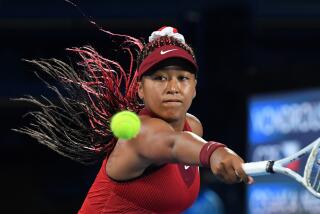Stabbing of Seles Jolts Tennis : Security: The incident at Hamburg tournament is expected to have an effect on accessibility of players.
- Share via
Jolted from its genteel ways when Monica Seles was stabbed in the back during a match Friday night in Hamburg, Germany, tennis may be facing a long, hot, uncomfortable summer.
“It’s going to affect the whole thinking of the game right now,” said Tom Keim, director of event marketing for Kraft-General Foods, title sponsor of the women’s professional tennis tour. “Tennis has always been so accessible to the public and you can go and get five feet away from some of the best-known athletes in the world. Now this is going to impact that.”
Seles was resting during a changeover when she was stabbed once in the back by a man who lunged out of the stands wielding a serrated-edged knife. Seles was carried off the court on a stretcher and hospitalized. According to hospital reports, her wound was not severe.
According to Reuters, the man told police he did it because he wanted Germany’s Steffi Graf to regain the No. 1 ranking in women’s tennis.
“The man said quite clearly that he did not want to kill Monica Seles,” police spokesman Dankmar Lundt told Reuters. “He only wanted to injure her and make her unable to play so that Steffi Graf could become No. 1 again.
“According to our information there was no political motive for the attack,” Lundt added, when asked about possible links between the conflict in former Yugoslavia and Serbian-born Seles.
Seles’ injury could put not only her Grand Slam schedule, but also her ranking in jeopardy. She may not be able to defend her singles title at the French Open, the year’s next Grand Slam event, which begins May 24 in Paris, or play at Wimbledon, starting June 21.
Security at the French Open is stringent, but not nearly as tight as at Wimbledon, where tournament officials routinely guard against the possibility of violence.
Bomb threats are commonplace at Wimbledon and officials there, under the direction of All England Club secretary Chris Gorringe, often clear the stands of spectators during matches. Police stationed at each entrance search parcels carried into the grounds. Unattended packages are confiscated.
Players moving from the changing rooms to the courts are escorted by uniformed police, but crowds often gather swiftly around the players and impede their movement.
But whether the sport is tennis at Wimbledon’s Centre Court, basketball in the Forum or golf at Augusta National, spectators are close to athletes, pointed out Steve DeVoe, tournament director of the U.S. Open.
“I think it’s a problem for every sport in general, not tennis in particular,” DeVoe said. “For instance, you’re even closer with basketball players.
“We’ve got to take whatever precautions we can and then do them better. But we already learned that you can’t even protect the President of the United States if someone wants to get him badly enough. This guy (John Hinckley Jr.) shot President Reagan because he was trying to impress a movie star.
“I just hope everyone keeps his powder dry until we find out some more about (the motive),” DeVoe said. “As for Wimbledon, they’ve been dealing with problems very expertly all along. But I’ll tell you one thing, this drives home the harsh reality that being a superstar in the modern age is not all glamour and excitement.”
Ranked No. 1 in the world for nearly three years, Seles clearly has enjoyed the trappings of success. At 19, she has won $7.4 million in prize money and commanded fees of more than $250,000 for playing such special events as the Pathmark Classic of promoter John Korff.
Perhaps more than any other promoter or tournament director, Korff has gotten to know the Seles family well.
“They are obsessed with security, they are obsessed with obsession,” Korff said. “I think a lot of it’s because of where they come from. They’re very private, very secret, very inward.”
The daughter of a cartoonist, Seles is of Hungarian descent and was born in the largely Serbian city of Novi Sad in the former Yugoslavia. The Seles family emigrated to Sarasota, Fla., when Monica was 13. At 15, she turned pro and a year later won her first Grand Slam event.
Since 1990, she has won seven of the eight Grand Slams she has played and cemented her reputation as the top female player in the world. Off the court, she fancied herself as a cover girl for fashion magazines, dreamed of a movie career and contemplated a move to Malibu.
When Seles skipped Wimbledon in 1991 because of a knee injury, she reveled in the publicity generated by her absence. Seles staged a picture for a photo agency, donning a black wig and stepping out of a white limousine.
She has always been quotable and entertaining in post-match interview sessions, although she has refused to discuss political events in her home country, even as it is torn apart by civil war. Such tennis-playing countrymen as Goran Ivanisevic, of Croatia, had been critical of Seles’ reluctance to acknowledge the affairs of her country and the manner in which she had distanced herself from what has been happening in her homeland.
Korff doubts that Seles will end her tennis career to avoid more danger.
“I don’t think it’ll make her quit playing tennis at all,” Korff said. “Tennis players thrive on adversity. And if she gives in, it only makes it easier for others to try the same thing on somebody else.
“And knowing the Seleses, gosh, once again she gets her face across the front page of every newspaper in the world,” he said.
* MAIN STORY: A1
More to Read
Go beyond the scoreboard
Get the latest on L.A.'s teams in the daily Sports Report newsletter.
You may occasionally receive promotional content from the Los Angeles Times.










